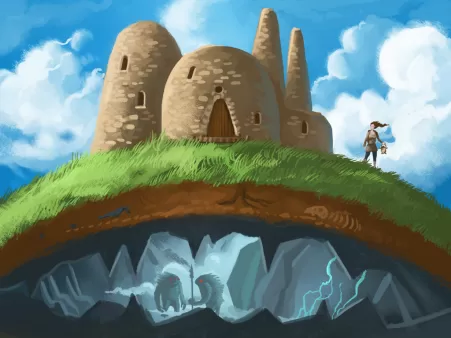
Courtesy of boardgamegeek.com
Welcome to a brand-new segment here at UnGeek called Cult of the New! A segment where we discuss the latest ‘hotness’ within the boardgaming community. This article is aimed at both old and new gamers alike to help them decide if this game is indeed worth picking up. We will also try (if possible) to compare it to some of the more-older games that feature the same mechanic.
To start things off we will go over (and under) this newly Kickstarted game Above and Below!
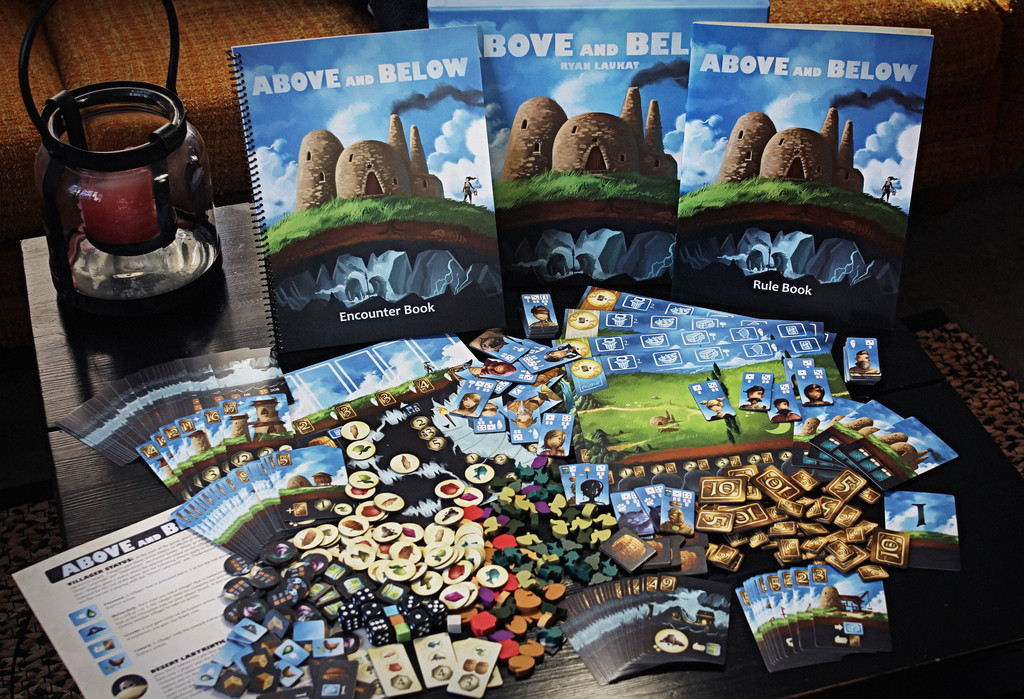
Courtesy of boardgamegeek.com
Above and Below is a 2-4 player game designed by Ryan Laukat (Artifacts, Inc., City of Iron, Eight-Minute Empire) and published by Red Raven Games. In this game you are a villager who just barely escaped from a raiding barbarian tribe that attacked your hometown. You and few other survivors have traveled far and wide and in doing so you found a patch of fertile land to start a new life in the process. Little did you know that beneath your location lies a vast network of caverns filled with potential riches. Because of your curiosity (and dire need of resources , you try to make use of what you have as you explore what lies both Above, and Below!
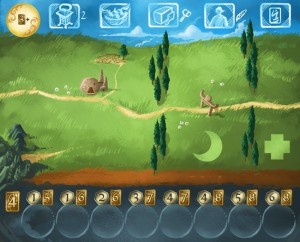
Courtesy of boardgamegeek.com
At its heart, this is an action-selection game that has a nice hybrid of mechanics such as Tableau-building, resource management, dice-rolling and storytelling. Contrary to what others are saying this actually does not have a worker-placement mechanic, since you are not contesting/blocking other players for spots on the board. Your villagers serve as your “action points” instead that determine how many actions you can do during a round. Succeeding here is determined by a number of factors but basically the player who built the most impressive village, gathered and utilized the most resources, having a great reputation and experienced the best stories will win him the game.
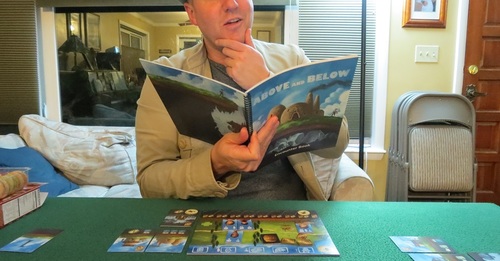
Courtesy of boardgamegeek.com
WAIT… Storytelling you say? We will get to that later! For now let’s look at the actions a player can choose in a turn.
Actions in the game:

Like I said, the game mainly revolves around an action selection mechanic. Each turn in clockwise order (Starting with the 1st player), you can choose 1 of 5 actions. Let go over them in detail:

- Building – To build, you must “exhaust” one of your villagers with a “hammer” symbol, placing it on the side of your player board with the “moon” symbol (to indicate it is exhausted). After that you can choose 1 of the 4 types of buildings available by paying the amount in coins showed on the upper left of the card.
The 4 types of buildings are:
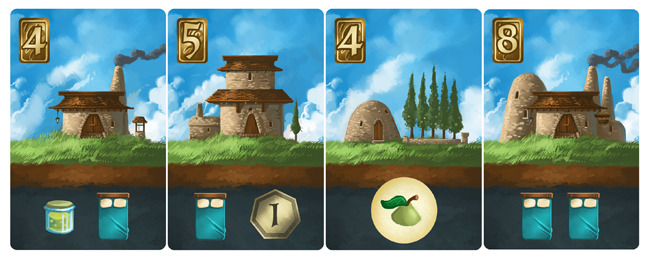
Courtesy of boardgamegeek.com
Regular Buildings: These are the basic buildings that you can build “above ground” and grants you different abilities such as gaining extra income, providing resources or generally giving you “extra beds” to refresh your villagers at the start of each round. Alternatively, as a free action (before starting you main action) a player can spend 1 coin to refresh the building cards and deal new ones.
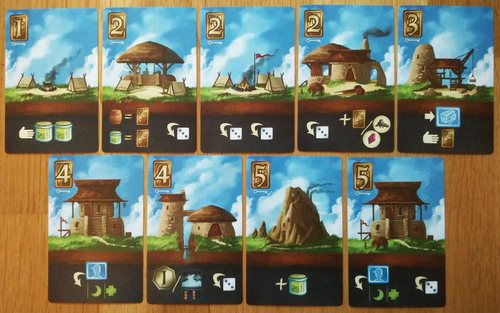
Courtesy of boardgamegeek.com
Key Buildings: There are always 4 random “Key Buildings” dealt in the board at the start of every game for variety. These are generally cheap to get and can help give you focus or dictate what additional abilities you can do during your turn (usually related to exploring) such as re-rolling dice in encounters.
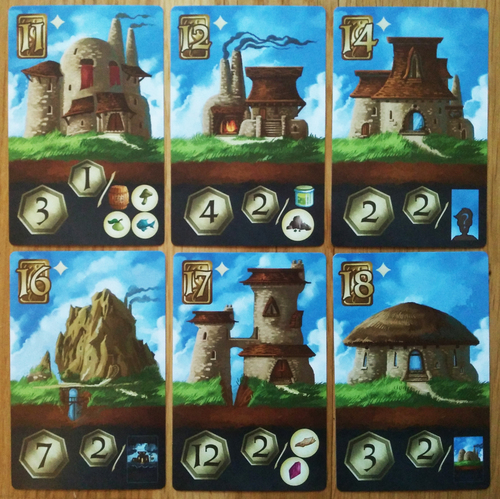
Courtesy of boardgamegeek.com
Star Buildings: These are the expensive buildings that will usually grant you the most points at the end of the game. When getting this you should consider strategies that focus on maximizing the abilities of these structures.
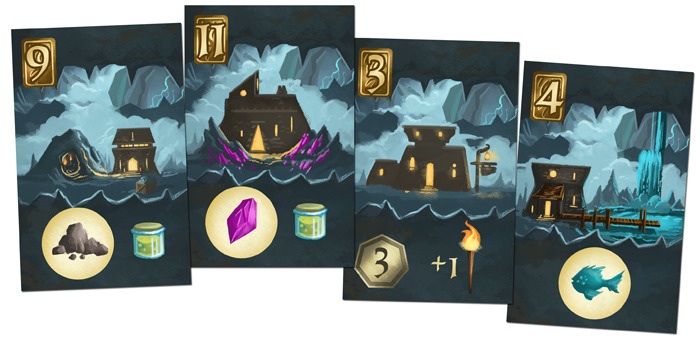
Courtesy of boardgamegeek.com
Underground Buildings (Outposts): These are just like the regular buildings that could give you various resources and abilities, but you can only build this below and empty cavern space, which you can normally acquire after a successful exploration (more on this as we tackle the storytelling part, I know you’re excited about this!).

- Harvest – To harvest, “exhaust” 1 villager (again placing them in the area with the moon symbol) and choose 1 building that provides a certain good, you can only get a maximum of 1 resource if it’s in a stack, which could be anything ranging from resources* or coin, and placing it near your tableau.
With these resources you can do a number of free actions before taking your main action and these are:

- Placing a resource on the upper left slot on your player board to indicate that the item “for sale”
- Buying a resource from another player, for a minimum value of 3 coins. This can go higher depending on the negotiation between players.

*Not necessarily an action, but at any time during the game (even if it’s not your turn) you can choose to place your goods on the “Advancement Track” on the bottom-row of your player board, starting from left to right. Once placed you can no longer remove them but you can still add resources of a similar good already there, placing them in a stack. Plan carefully when doing this as this can provide you with coins and end-game points when done efficiently.

- Hire/Train – To hire, “exhaust” one available villager and choose one of the available villagers in the center area, paying the appropriate amount of coin and placing them in the “exhausted area.” In this way you are generally gaining more workers (with varying abilities) that give you more actions in a round.

- Labor – “Exhaust” 1 villager to gain 1 coin. If you are the first player to do this in a round you have the extra benefit of obtaining the “Ale” tile, which you can give to one of your villagers to help them refresh or recover without having to use a bed during the start of a round.

- Explore – Finally we get to my favorite part of the game! To explore, a player must choose 2 villagers and place them on top of the stack of “Cavern Cards” and roll a die, which determines the paragraph the other player will read in the Adventure Book.
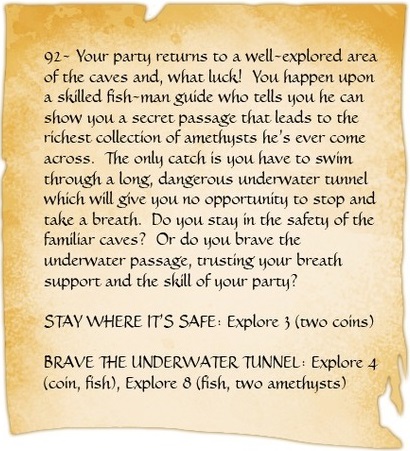
Courtesy of boardgamegeek.com
The player adventuring will be read a story and usually be presented with a minimum of 2 options, which could range from doing good things such as (but not limited to) rescuing/helping/giving/negotiating or not so good things like ignoring/attacking/taking/stealing and the like.
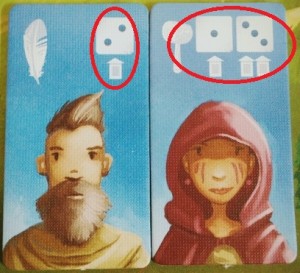
The player chooses what he does and rolls a dice for each villager participating, checking the number of lanterns (successes) rolled on the top part of the villager tile.
The player can either “succeed”, or a “nothing happens” or a “fail” depending on the number of lanterns (Explore X value) rolled. Alternatively, a player can “exert” or “injure” a villager to add 1 success to the result, placing them in the injured (+) area of the player board, lengthening the “recovery time” a villager will refresh during a round.

This offers a nice risk-reward system that could affect your overall reputation at the end of the game. What’s even greater about this is that some resources, items and even powerful characters can only be obtained when adventuring or having an encounter. In some cases, it could even net you with a lot of coin!
At the end of 7 rounds, the player with the most number of points — usually by building, gathering resources, adventuring (also having a good standing on the reputation track) — wins! So here are my final thoughts about the game:
 The Good:
The Good:
- The game presents a nice amalgamation or mechanics. Especially with the storytelling/adventuring part integrated very well into the action. There are 2 other games that come into mind that are similar to this – Tales of the Arabian Nights and Agents of Smersh. While both are awesome games. I personally feel that the story element works better in Above and Below, where you have more control of what to expect, also it doesn’t feel as random as the other games mentioned (trust me, as much as I love Tales of the Arabian Nights, it feels more of a “ride” than a “game.”) Sure, the stories are still random, but it often presents you with options that are generally doable, depending on the characters you bring to the encounter. And with the right “exertion,” failure can be mitigated.
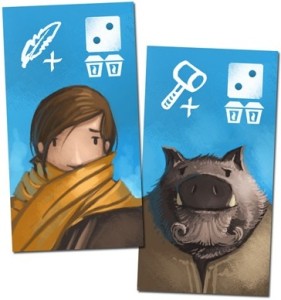
- Workers/Villagers aren’t just generic pieces. Each one has their own skills depending the icons, especially the special characters that you can recruit or obtain in an encounter. Heck, they even have their own unique art!
- Speaking of art, the art in the game is gorgeous! Ryan Laukat really did a great job making each element in the game unique, from the player boards to the buildings and the characters. The iconography is clear and the colors used are really nice and provides a real “eye candy” when seen at the table. Just amazing.
- Easy to teach and can appeal to hardcore and casual gamers alike. Once everyone has a grasp of the 5 actions, the game flows real smoothly. They are very simple and straightforward to execute. I could easily moderate this game with new players as long they understand that you can do 1 of 5 actions on your turn. This allows the game to move at a much faster pace which leaves me to one more positive thing:
- The game doesn’t overstay its welcome. After a few sessions an average game time is around an hour-and-a-half for my group. One could say that there is downtime involved when a players goes adventuring but keep in mind – an encounter doesn’t happen to a player every turn! It is entirely optional. And even with that, I always had a fun time listening to other player’s adventures. And at times I even wanted them to succeed, just to see what reward they could get.

The Bad:
- When you fail at an encounter, you receive nothing. No reward, you don’t even get the Cavern Card to use for building later! This could be a let-down to some, especially when you realize that you just wasted an action for 2 villagers. This might be a minor complaint but must be mentioned.
- That feeling when you could do more but the game has only 7 rounds. Again this might be an issue to some players, especially those who want a bit more or someone making that alpha move but was too late because you didn’t have enough time (or coin) in acquiring that “Star Building.”
 If you want a numerical rating I personally will give this a 4/5 fingers! With 4 fingers pointing above and my thumb pointing below (if that’s even possible :p).
If you want a numerical rating I personally will give this a 4/5 fingers! With 4 fingers pointing above and my thumb pointing below (if that’s even possible :p).
And there you have it! Thanks for reading all the way to the end! I’m sure there are some stuff that I missed out, so feel free to leave a comment or a feedback. I hope you give this gave a try at least, it really is a fresh new take on various gaming mechanics which might be surprise you!
Interested in grabbing a copy? Gaming Library sells it here in the Philippines for P2,600. See you in the next installment of Cult of the New and keep on gaming!

